Extreme Value Theory in Application to Delivery Delays
Abstract
1. Introduction
2. Extreme Value Theory—A Methodological Background
3. EVT in Modeling and Forecasting of Delivery Delays
3.1. Data Characteristics
- The management perspective, i.e., cargo management, determining optimal routes, analysis of the delivery time from the standpoint of planning, the technical and operational readiness of vehicles, and proper structure of contracts with subcontractors.
- The road conditions perspective related to the possibility of dynamic changes on the road such as the occurrence of random events and hazards on the road (accidents, collisions), congestion, and changes in weather conditions.
- The driver’s behavior perspective, including defective implementation of the plan, received from transport managers, psychophysical condition of the driver (exhaustion, stress), and irrational behavior on the road.
3.2. The Empirical Results
4. Discussion
5. Conclusions
Author Contributions
Funding
Institutional Review Board Statement
Informed Consent Statement
Data Availability Statement
Conflicts of Interest
References
- Davison, A.C.; Smith, R.L. Models for exceedances over high thresholds. J. R. Stat. Soc. Ser. B (Methodol.) 1990, 52, 393–442. Available online: https://www.jstor.org/stable/2345667 (accessed on 21 June 2021). [CrossRef]
- Tawn, J.A. Estimating probabilities of extreme sea-levels. Appl. Stat. 1992, 41, 77–93. [Google Scholar] [CrossRef]
- De Haan, L.; de Ronder, J. Sea and wind: Multivariate extremes at work. Extremes 1998, 7, 7–45. [Google Scholar] [CrossRef]
- Barão, M.I.; Tawn, J.A. Extremal analysis of short series with outliers: Sea-levels and athletic records. J. R. Stat. Soc. 1999, 48, 469–487. [Google Scholar] [CrossRef]
- Nadarajah, S.; Shiau, J.T. Analysis of extreme flood events for the pachang river Taiwan. Water Resour. Manag. 2005, 9, 363–374. [Google Scholar] [CrossRef]
- Katz, R.W.; Parlange, M.B.; Naveau, P. Statistics of extremes in hydrology. Adv. Water Resour. 2002, 25, 1287–1304. [Google Scholar] [CrossRef]
- Caires, S.; Swail, V.R.; Wang, X.L. Projection and analysis of extreme wave climate. J. Clim. 2006, 19, 5581–5605. [Google Scholar] [CrossRef]
- Panagoulia, D.; Economou, P.; Caroni, C. Stationary and nonstationary generalized extreme value modelling of extreme precipitation over a mountainous area under climate change. Environmetrics 2014, 25, 29–43. [Google Scholar] [CrossRef]
- Masingi, V.N.; Maposa, D. Modelling long-term monthly rainfall variability in selected provinces of South Africa: Trend and extreme value analysis approaches. Hydrology 2021, 8, 70. [Google Scholar] [CrossRef]
- McNeil, A.J. Extreme value theory for risk managers. In Internal Modelling and CAD II; RISK Books: London, UK, 1999; pp. 93–113. [Google Scholar]
- Danielsson, J.; DE Vries, C.G. Value-at-risk and extreme returns. Ann. D’economie Stat. 2000, 60, 239–270. [Google Scholar] [CrossRef]
- McNeil, J.A.; Frey, F. Estimation of tail-related risk measures for heteroscedastic financial time series: An extreme value approach. J. Empir. Financ. 2000, 7, 271–300. [Google Scholar] [CrossRef]
- Fałdziński, M.; Osińska, M.; Zdanowicz, T. Detecting risk transfer in financial markets using different risk measures. Cent. Eur. J. Econ. Model. Econom. 2012, 1, 45–64. [Google Scholar]
- Bień-Barkowska, K. Looking at extremes without going to extremes: A new self-exciting probability model for extreme losses in financial markets. Entropy 2020, 22, 789. [Google Scholar] [CrossRef]
- Božović, M. Portfolio tail risk: A multivariate extreme value theory approach. Entropy 2020, 22, 1425. [Google Scholar] [CrossRef]
- Fałdziński, M.; Osińska, M. The use of range-based volatility estimators in testing for Granger causality in risk on international capital markets. J. Risk Model Valid. 2020, 14. [Google Scholar] [CrossRef]
- Gijbels, I.; Kika, V.; Omelka, M. Multivariate tail coefficients: Properties and estimation. Entropy 2020, 22, 728. [Google Scholar] [CrossRef]
- Trucíos, C.; Tiwari, A.V.; Alqahtani, F. Value-at-risk and expected shortfall in cryptocurrencies’ portfolio: A vine copula–based approach. Appl. Econ. 2020, 52, 2580–2593. [Google Scholar] [CrossRef]
- Kagan, Y.Y. Earthquake size distribution and earthquake insurance. Commun. Stat. Stoch. Models 1997, 13, 775–797. [Google Scholar] [CrossRef]
- Strand, M.; Boes, D. Modeling road racing times of competitive recreational runners using extreme value theory. Am. Stat. 1998, 52, 205–210. [Google Scholar]
- Zheng, L.; Sayed, T. Application of extreme value theory for before-after road safety analysis. Transp. Res. Rec. 2019, 2673, 1001–1010. [Google Scholar] [CrossRef]
- Orsini, F.; Gecchele, G.; Gastaldi, M.; Rossi, R. Large-scale road safety evaluation using extreme value theory. IET Intell. Transp. Syst. 2020, 14. [Google Scholar] [CrossRef]
- Esfeh, M.A.; Kattan, L.; Lam, W.H.K.; Esfe, R.A.; Salari, M. Compound generalized extreme value distribution for modeling the effects of monthly and seasonal variation on the extreme travel delays for vulnerability analysis of road network. Transp. Res. Part C 2020, 120, 102808. [Google Scholar] [CrossRef]
- Abadi, A.; Ioannou, P.A.; Dessouky, M.M. Multimodal dynamic freight load balancing. IEEE Trans. Intell. Transp. Syst. 2016, 2, 356–366. [Google Scholar] [CrossRef]
- Chen, D.; Ignatius, J.; Sun, D.; Goh, M.; Zhan, S. Impact of congestion pricing schemes on emissions and temporal shift of freight transport. Transp. Res. Part E 2018, 118, 77–105. [Google Scholar] [CrossRef]
- Cavone, G.; Dotoli, M.; Seatzu, C. A survey on petri net models for freight logistics and transportation systems. IEEE Trans. Intell. Transp. Syst. 2017, 6, 1795–1813. [Google Scholar] [CrossRef]
- Iordanidou, G.; Papamichail, I.; Roncoli, C.; Papageorgiou, M. Feedback-based integrated motorway traffic flow control with delay balancing. IEEE Trans. Intell. Transp. Syst. 2017, 9, 2319–2329. [Google Scholar] [CrossRef]
- Wang, T.; Xing, Z.; Hu, H.; Qu, X. Overbooking and delivery-delay-allowed strategies for container slot allocation. Transp. Res. Part E 2019, 433–447. [Google Scholar] [CrossRef]
- Fisher, R.A.; Tippett, L.H.C. Limiting forms of the frequency distribution of the largest or smallest member of a sample. Math. Proc. Camb. Philos. Soc. 1928, 24, 180–290. [Google Scholar] [CrossRef]
- Embrechts, P.; Klüppelberg, C.; Mikosch, T. Modelling Extremal Events for Insurance and Finance; Springer: New York, NY, USA, 2003. [Google Scholar]
- Coles, S.G.; Dixon, M.J. Likelihood-based inference for extreme value models. Extremes 1999, 1, 5–23. [Google Scholar]
- McNeil, A.J. Calculating Quantile Risk Measures for Financial Time Series Using Extreme Value Theory; ETH Zurich: Zurich, Switzerland, 1998. [Google Scholar] [CrossRef]
- Coles, S.G. An Introduction to Statistical Modeling of Extreme Values; Springer: New York, NY, USA, 2001. [Google Scholar]
- Smith, R.L.; Weissman, I. Estimating the extremal index. J. R. Stat. Soc. Ser. B (Methodol.) 1994, 3, 515–528. [Google Scholar] [CrossRef]
- O’Brien, G. Extreme values for stationary and Markov sequences. Ann. Probab. 1987, 15, 281–291. [Google Scholar] [CrossRef]
- Ferro, C.A.T.; Segers, J. Inference for clusters of extreme values. J. R. Stat. Soc. Ser. B (Methodol.) 2003, 65, 545–556. [Google Scholar] [CrossRef]
- Süveges, M. Likelihood estimation of the extremal index. Extremes 2007, 10, 41–55. [Google Scholar] [CrossRef]
- Jarque, C.M.; Bera, A.K. A test for normality of observations and regression residuals. Int. Stat. Rev. 1987, 55, 163–172. [Google Scholar] [CrossRef]
- Cameron, A.C.; Trivedi, P.K. Essentials of count data regression. In A Companion to Theoretical Econometrics; Baltagi, P.H., Ed.; Blackwell: Oxford, UK, 2001; pp. 331–348. [Google Scholar]
- Winkelmann, R. Econometric Analysis of Count Data; Springer: Berlin/Heidelberg, Germany, 2008. [Google Scholar]
- Hilbe, J.M. Modeling Count Data; Cambridge University Press: Cambridge, UK, 2014. [Google Scholar]
- Neath, A.A.; Cavanaugh, J.E. The Bayesian information criterion: Background, derivation, and applications. Wiley Interdiscip. Rev. Comput. Stat. 2012, 4, 199–203. [Google Scholar] [CrossRef]
- Fawcett, L.; Walshaw, D. Extreme Values: Statistical Analysis Using R; Wiley: Hoboken, NJ, USA, 2016. [Google Scholar]
- Alam, M.A.; Emura, K.; Farnham, C.; Yuan, J. Best-fit probability distributions and return periods for maximum monthly rainfall in Bangladesh. Climate 2018, 6, 9. [Google Scholar] [CrossRef]
- Iyamuremye, E.; Mung’atu, J.; Mwita, P. Extreme value modelling of rainfall using poisson-generalized pareto distribution: A case study tanzania. Int. J. Stat. Distrib. Appl. 2019, 5, 67–75. [Google Scholar] [CrossRef][Green Version]
- Anderson, T.W.; Darling, D.A. A Test of goodness-of-fit. J. Am. Stat. Assoc. 1954, 49, 765–769. [Google Scholar] [CrossRef]
- Cramér, H. On the composition of elementary errors. Scand. Actuar. J. 1928, 1, 13–74. [Google Scholar] [CrossRef]
- Mises, R.E. Wahrscheinlichkeit, Statistik und Wahrheit; Springer: Berlin/Heidelberg, Germany, 1928; Available online: https://www.springer.com/de/book/9783662418635 (accessed on 21 June 2021).
- Trkman, P.; Stemberger, M.I.; Jaklic, J.; Groznik, A. Process approach to supply chain integration. Supply Chain. Manag. 2007, 12, 116–128. [Google Scholar] [CrossRef]
- Zeng, A.Z. Global sourcing: Process and design for efficient management. Supply Chain Manag. 2003, 8, 367–379. [Google Scholar] [CrossRef]
- Christopher, M. Logistics and Supply Chain Management: Creating Value-Adding Networks; Prentice Hall: London, UK, 2005; Available online: https://www.mscceducation.com/wp-content/uploads/2019/06/SCM-Logistics-and-SCM-Creating-value-added-networks-Pg-1-to-17.pdf (accessed on 21 June 2021).
- Lambert, D.M.; García-Dastugue, S.J.; Croxton, K.L. An evaluation of process-oriented supply chain management frameworks. J. Bus. Logist. 2005, 26, 25–51. [Google Scholar] [CrossRef]
- Gunasekaran, A.; Lai, K.-H.; Cheng, T.C.E. Responsive supply chain: A competitive strategy in a networked economy. Omega 2008, 36, 549–564. [Google Scholar] [CrossRef]
- Dörnhöfer, M.; Schröder, F.; Günthner, W.A. Logistics performance measurement system for the automotive industry. Logist. Res. 2016, 9. [Google Scholar] [CrossRef]
- Kumar, R.S.; Pugazhendhi, S. Information sharing in supply chains: An overview. Procedia Eng. 2012, 38, 2147–2154. [Google Scholar] [CrossRef]
- Guel-Cortez, A.J.; Kim, E.-J. Information length analysis of linear autonomous stochastic processes. Entropy 2020, 22, 1265. [Google Scholar] [CrossRef]
- Önalan, O. The Ornstein-uhlenbeck processes driven by lévy process and application to finance. Electron. Eng. Comput. Technol. 2010, 60, 443–453. [Google Scholar] [CrossRef]
- Kou, S. A jump-diffusion model for option pricing. Manag. Sci. 2002, 48, 1086–1101. [Google Scholar] [CrossRef]
- Wang, P. Markov zero-inflated Poisson regression models for a time series of counts with excess zeros. J. Appl. Stat. 2001, 28, 623–632. [Google Scholar] [CrossRef]
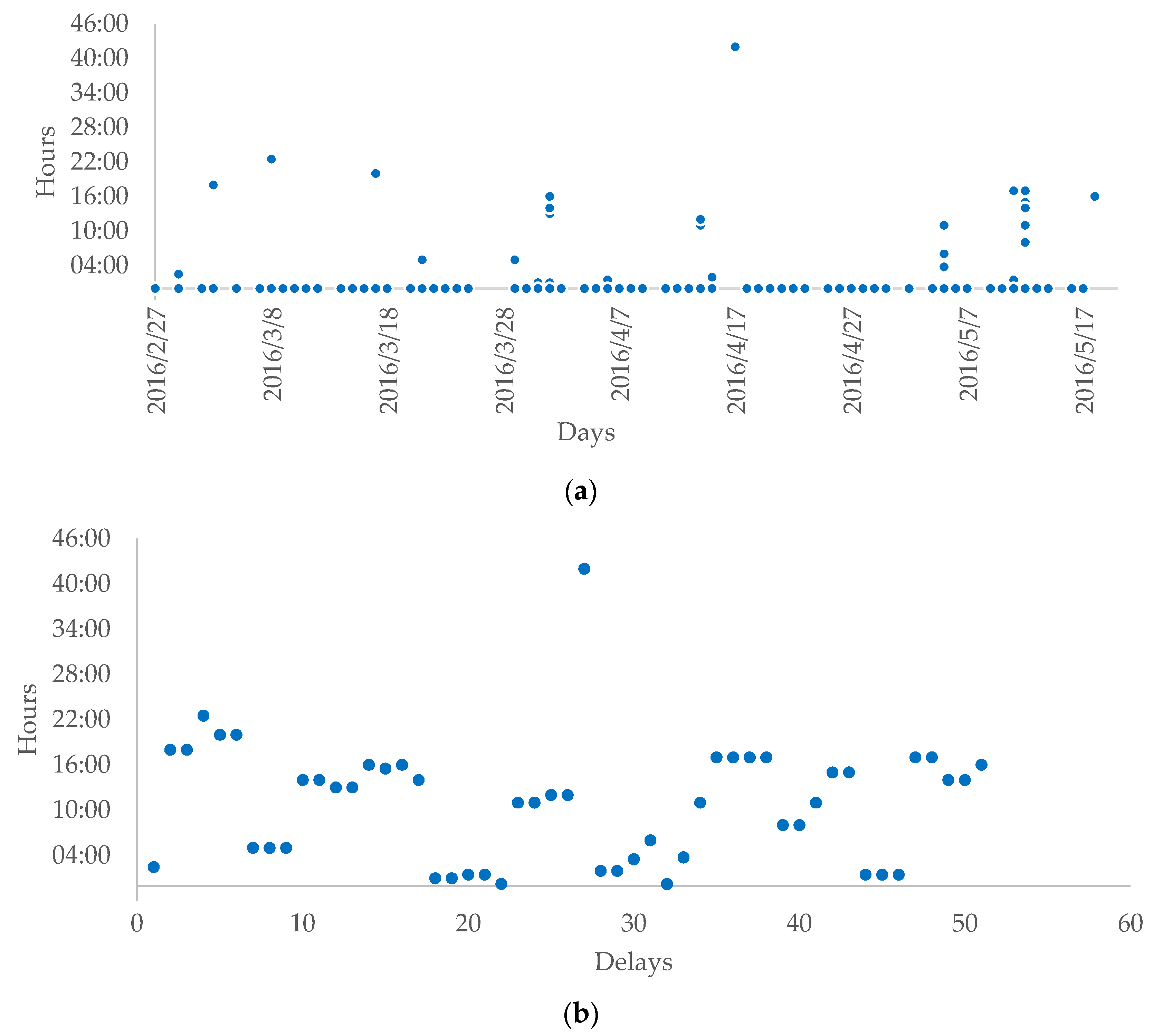
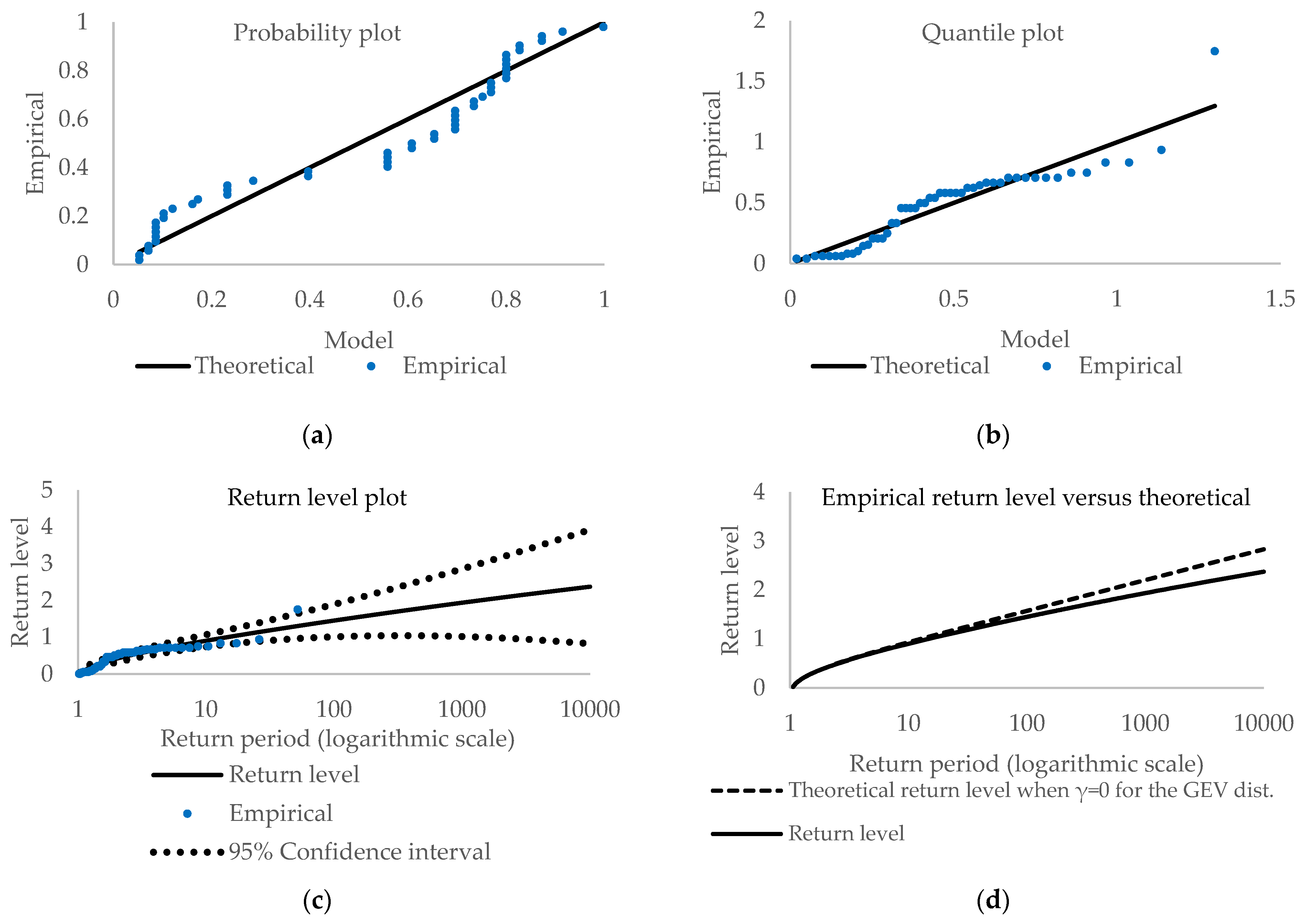
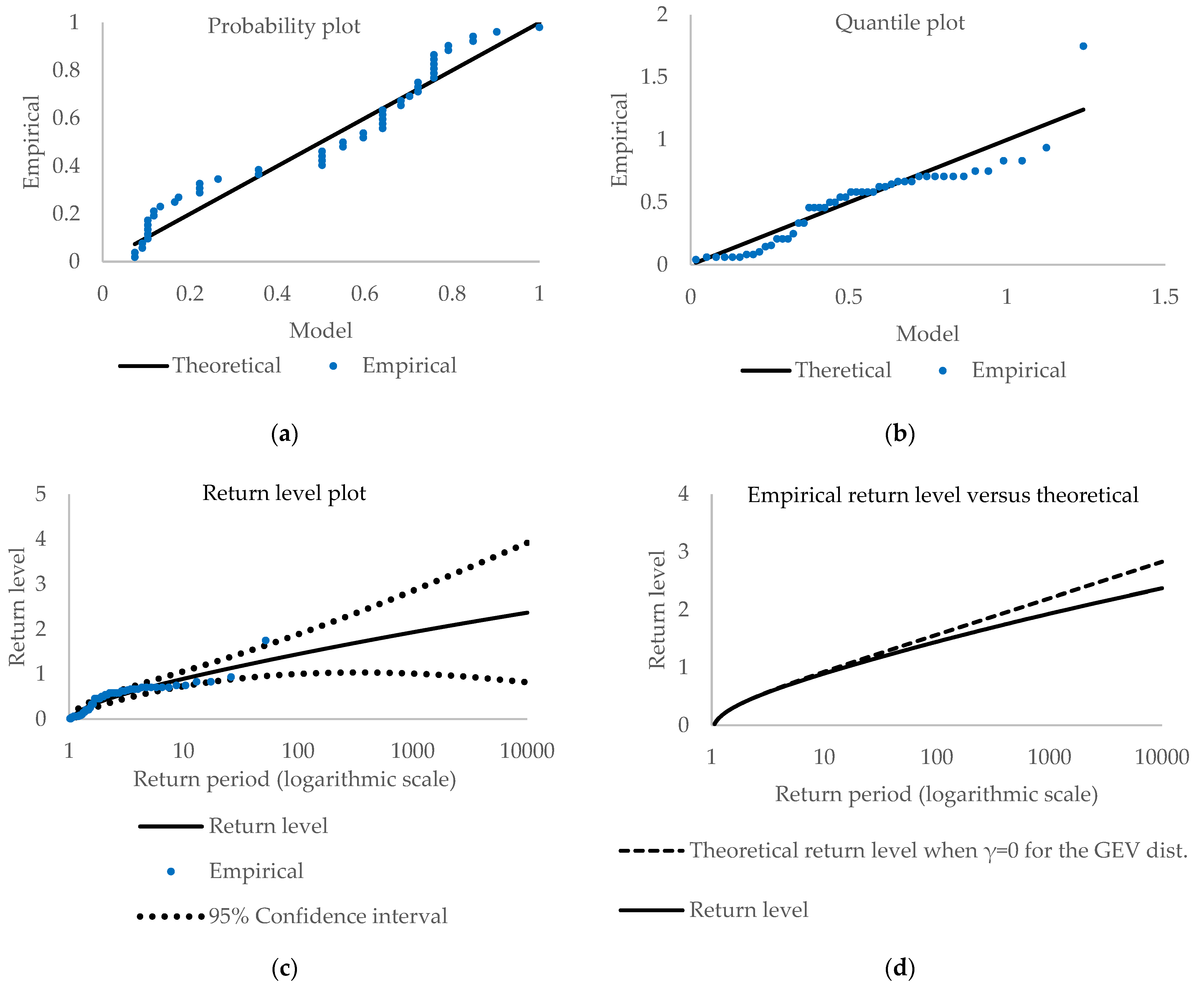
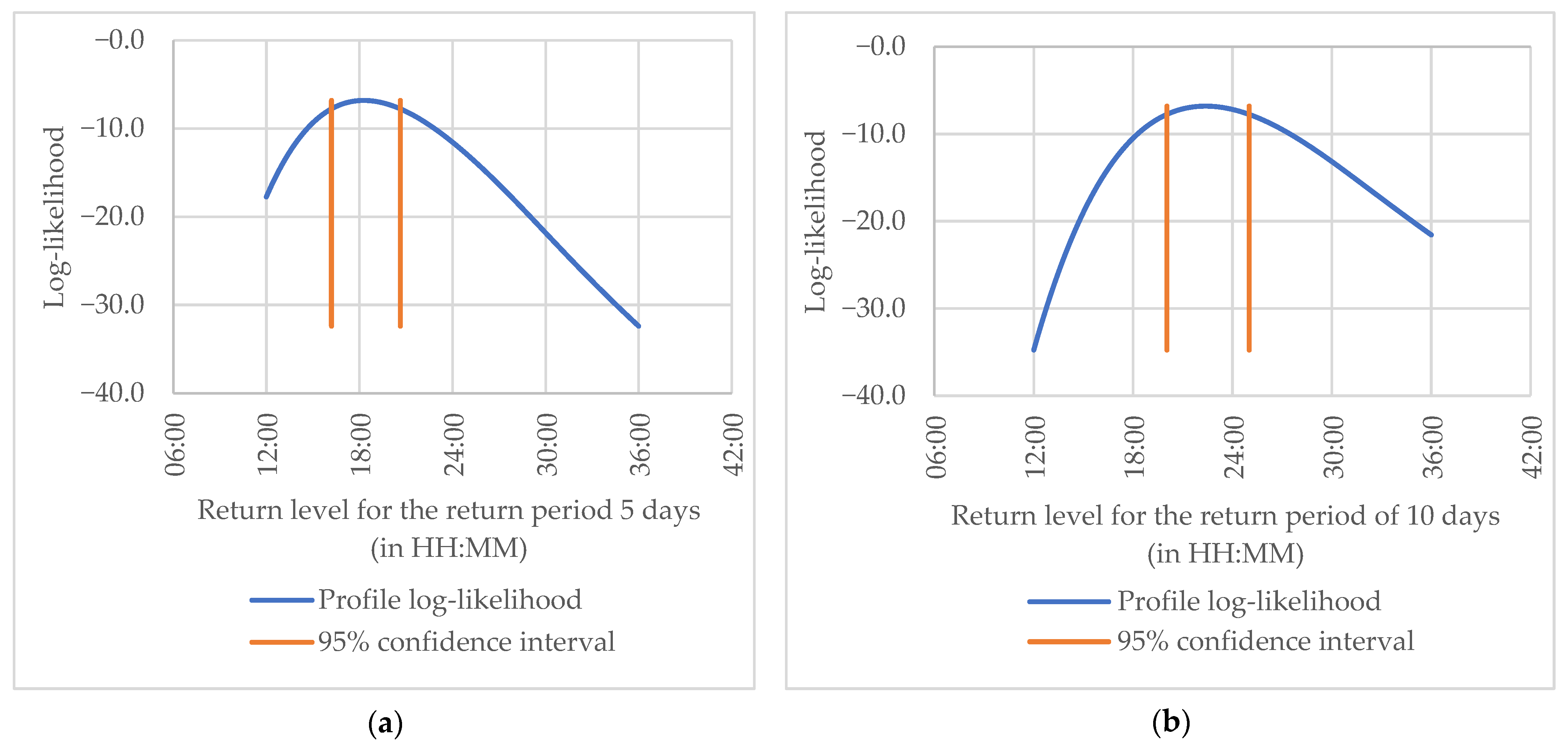
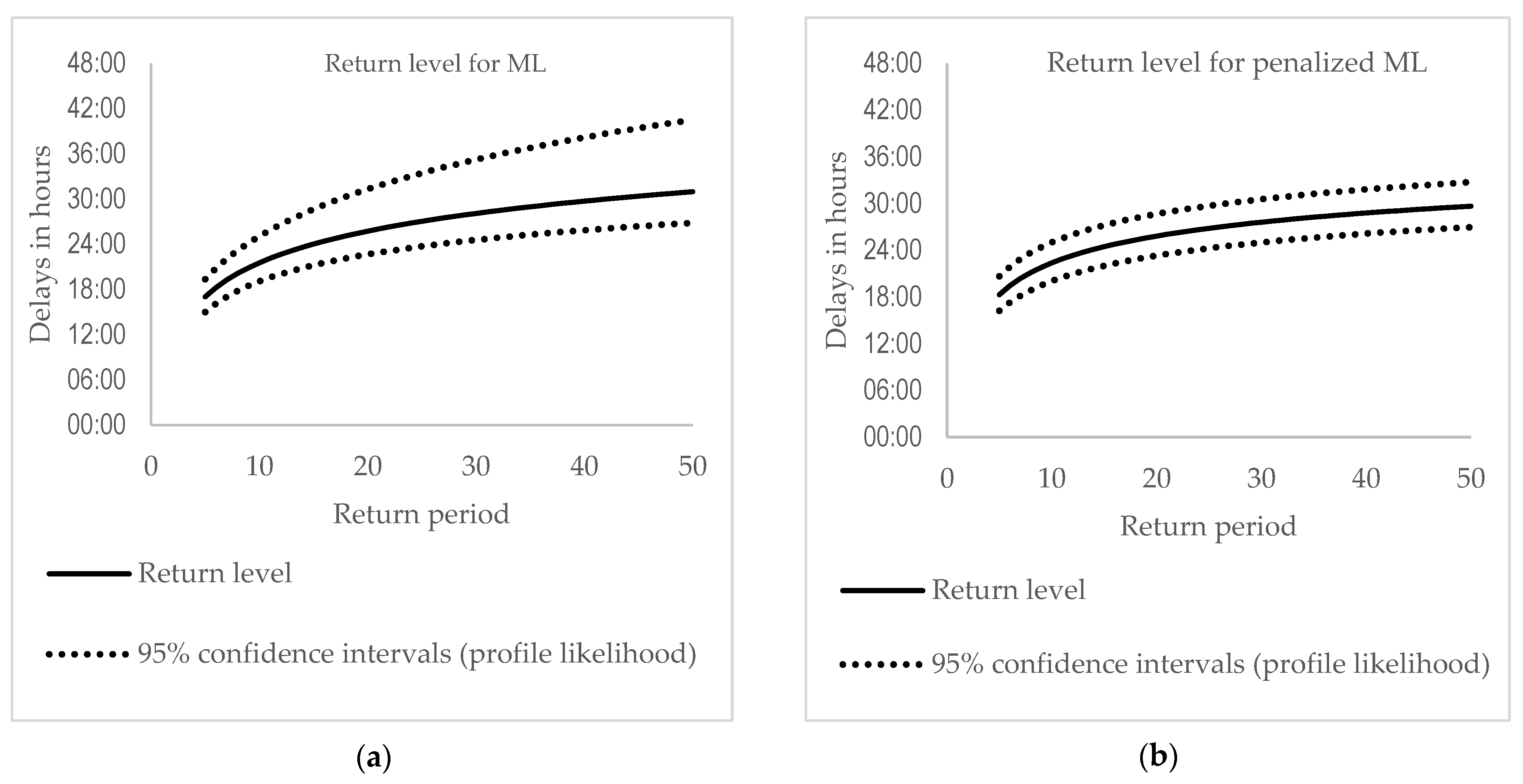
| No. of Obs. | Min | Max | Median | Mean | Std. dev. | Kurt | Skew | JB Stat | JB p-Value |
|---|---|---|---|---|---|---|---|---|---|
| 3770 | 00:00:00 | 42:00:00 | 00:00:00 | 00:08:48 | 01:32:52 | 228.939 | 13.366 | 8,131,073 | 0.000 |
| 51 | 00:15:00 | 42:00:00 | 12:00:00 | 10:59:45 | 07:54:33 | 5.665 | 0.942 | 22.634 | 0.000 |
| ML | Coefficient | Std. Error | p-Value |
| γ | −0.0452 | 0.0981 | 0.6449 |
| μ | 0.3129 | 0.0431 | 0.0000 |
| σ | 0.2731 | 0.0316 | 0.0000 |
| Log likelihood | −12.7468 | BIC | 0.7312 |
| Penalized ML | Coefficient | Std. Error | p-Value |
| γ | −0.1802 | 0.0434 | 0.0000 |
| μ | 0.3435 | 0.0473 | 0.0000 |
| σ | 0.3182 | 0.0402 | 0.0000 |
| Log likelihood | −6.8146 | BIC | 0.4985 |
| ML | PML | |||
|---|---|---|---|---|
| Statistic | p-Value | Statistic | p-Value | |
| Anderson-Darling | 1.8794 | 0.1071 | 2.0173 | 0.089 |
| Cramer-von Mises | 0.3096 | 0.1269 | 0.2923 | 0.1420 |
| Blocks Method | Runs Method | Ferro and Segers | |
|---|---|---|---|
| Extremal index | 0.4403 | 0.2941 | 0.3193 |
| 2.27 | 3.40 | 3.13 | |
| Extremal index | 0.3931 | 0.3137 | 0.3193 |
| 2.54 | 3.19 | 3.13 |
Publisher’s Note: MDPI stays neutral with regard to jurisdictional claims in published maps and institutional affiliations. |
© 2021 by the authors. Licensee MDPI, Basel, Switzerland. This article is an open access article distributed under the terms and conditions of the Creative Commons Attribution (CC BY) license (https://creativecommons.org/licenses/by/4.0/).
Share and Cite
Fałdziński, M.; Osińska, M.; Zalewski, W. Extreme Value Theory in Application to Delivery Delays. Entropy 2021, 23, 788. https://doi.org/10.3390/e23070788
Fałdziński M, Osińska M, Zalewski W. Extreme Value Theory in Application to Delivery Delays. Entropy. 2021; 23(7):788. https://doi.org/10.3390/e23070788
Chicago/Turabian StyleFałdziński, Marcin, Magdalena Osińska, and Wojciech Zalewski. 2021. "Extreme Value Theory in Application to Delivery Delays" Entropy 23, no. 7: 788. https://doi.org/10.3390/e23070788
APA StyleFałdziński, M., Osińska, M., & Zalewski, W. (2021). Extreme Value Theory in Application to Delivery Delays. Entropy, 23(7), 788. https://doi.org/10.3390/e23070788






